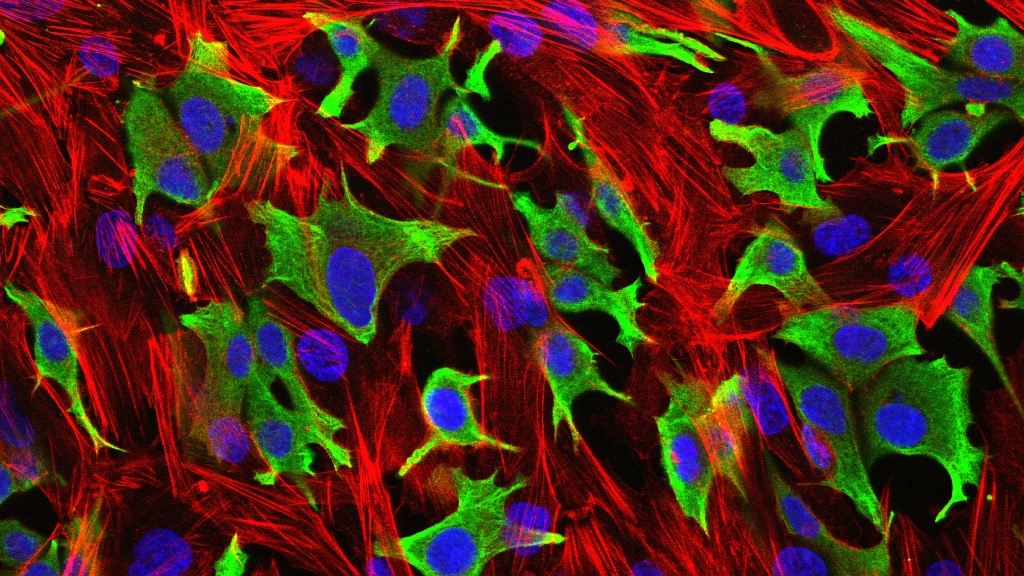
Targeting AMPK as a metabolic vulnerability of metastatic cancer cells
Application closing date: 16/11/25
Project background
Metastatic cells are characterised as being highly invasive but weakly adhesive with rounded-amoeboid like features. These cells harbour high levels of cortical Myosin II activity and exert low magnitude traction forces into the extracellular matrix (ECM). Their low adhesion to the matrix results in decreased engagement in mitochondrial metabolism and alterations in ATP and AMP intracellular levels that lead to AMP-activated protein kinase (AMPK) activation.
Once AMPK is active, it directly phosphorylates the crucial regulator of cytoskeletal dynamics Myosin phosphatase (Myosin phosphatase target subunit 1, MYPT1) in the key residue for its inactivation, leading to increased Myosin Light Chain phosphorylation and increased overall Myosin II activity. At the same time, AMPK induces mitochondrial fission through the phosphorylation of Mitochondrial Fission Factor (MFF), which sustains the imbalance in energy levels, further boosting AMPK signalling and Myosin II activation. In contrast, highly adhesive elongated-mesenchymal cells present highly fused and active mitochondria. This provides energy for mesenchymal cancer cells to exert strong adhesive traction stress, while it maintains lower levels of AMPK signalling, resulting in moderate Myosin II activity. Strong adhesions in elongated-mesenchymal cells rely on Discoidin Domain Receptor 1 (DDR1) collagen receptor. Reducing DDR1-dependent adhesion, inhibiting mitochondrial fusion or inducing AMPK activity in elongated-mesenchymal cells promotes the transition to rounded-amoeboid efficient migration/invasion and all its cytoskeletal/mitochondrial features. Conversely, inhibiting AMPK reduces metastatic potential of cancer cells.
Project aims
- Screen compound libraries of molecular glue degraders for compounds able to degrade subunits of AMPK.
- Generate PROTACs from existing inhibitors, to increase selectivity and potency.
- Test identified compounds (molecular glue degraders) for their ability to impair AMPK functions leading to diminished metastatic potential in vitro, by assessing amoeboid features, cell rounding, Myosin II activity, mitochondrial function and traction stresses.
- Test selected compounds (molecular glue degraders) in vivo in cancer models for melanoma and breast cancer for their ability to reduce metastasis.
Further details & requirements
We propose that targeting AMPK would represent a promising therapeutic strategy for the treatment of metastatic cancers. Recent advancements in the field of targeted protein degradation have allowed for the development of compounds that can be used to degrade their substrates. In this project, we shall identify and develop molecules can be used to degrade AMPK and these for their ability to target metastatic cancer cells, focusing on melanoma and breast cancer.
This proposal will incorporate the use of unique large-scale chemical libraries of molecular glue degraders as well as in vitro and in vivo models of breast cancer and melanoma, with the aim of developing novel therapeutic approaches to treat metastatic cancer.
- At least a 2:1 degree in a relevant scientific subject
[1] Crosas-Molist E, Graziani V, Maiques O, Pandya P, Monger J, Samain R, George SL, Malik S, Salise J, Morales V, Le Guennec A, Atkinson RA, Marti RM, Matias-Guiu X, Charras G, Conte MR, Elosegui-Artola A, Holt M, Sanz-Moreno V. AMPK is a mechano-metabolic sensor linking cell adhesion and mitochondrial dynamics to Myosin-dependent cell migration. Nat Commun. 2023 May 22;14(1):2740. doi: 10.1038/s41467-023-38292-0. PMID: 37217519; PMCID: PMC10202939.
[2] Maiques O, Sallan MC, Laddach R, Pandya P, Varela A, Crosas-Molist E, Barcelo J, Courbot O, Liu Y, Graziani V, Arafat Y, Sewell J, Rodriguez-Hernandez I, Fanshawe B, Jung-Garcia Y, Imbert PR, Grasset EM, Albrengues J, Santacana M, Macià A, Tarragona J, Matias-Guiu X, Marti RM, Tsoka S, Gaggioli C, Orgaz JL, Fruhwirth GO, Wallberg F, Betteridge K, Reyes-Aldasoro CC, Haider S, Braun A, Karagiannis SN, Elosegui-Artola A, Sanz-Moreno V. Matrix mechano-sensing at the invasive front induces a cytoskeletal and transcriptional memory supporting metastasis. Nat Commun. 2025 Feb 14;16(1):1394. doi: 10.1038/s41467-025-56299-7.
[3] Hinterndorfer M, Spiteri VA, Ciulli A, Winter GE. Targeted protein degradation for cancer therapy. Nat Rev Cancer. 2025 Jul;25(7):493-516. doi: 10.1038/s41568-025-00817-8. Epub 2025 Apr 25. PMID: 40281114.
[4] Orgaz JL, Crosas-Molist E, Sadok A, Perdrix-Rosell A, Maiques O, Rodriguez-Hernandez I, Monger J, Mele S, Georgouli M, Bridgeman V, Karagiannis P, Lee R, Pandya P, Boehme L, Wallberg F, Tape C, Karagiannis SN, Malanchi I, Sanz-Moreno V.Myosin II Reactivation and Cytoskeletal Remodeling as a Hallmark and a Vulnerability in Melanoma Therapy Resistance. Cancer Cell. 2020 Jan 13;37(1):85-103.e9. doi: 10.1016/j.ccell.2019.12.003.
[5] Georgouli M, Herraiz C, Crosas-Molist E, Fanshawe B, Maiques O, Perdrix A, Pandya P, Rodriguez-Hernandez I, Ilieva KM, Cantelli G, Karagiannis P, Mele S, Lam H, Josephs DH, Matias-Guiu X, Marti RM, Nestle FO, Orgaz JL, Malanchi I, Fruhwirth GO, Karagiannis SN, Sanz-Moreno V. Regional Activation of Myosin II in Cancer Cells Drives Tumor Progression via a Secretory Cross-Talk with the Immune Microenvironment. Cell. 2019 Feb 7;176(4):757-774.e23. doi: 10.1016/j.cell.2018.12.038. Epub 2019 Jan 31